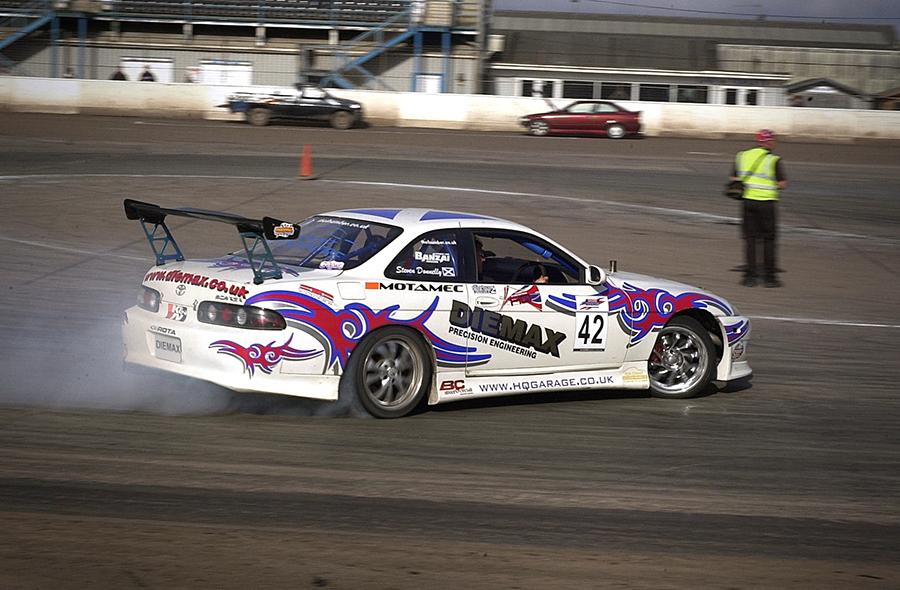Bright lights flash as a police officer tailgates a white 1991 Nissan 240SX.
Skyline student Jose Flores recalls the night he was pulled over blocks away from his house.
The officer jots down Flores’ information and inquires about the car. Surprisingly, he then asks him if he drifts.
“Yes, but at the track,” replied Flores without a clue as to what he has done wrong.
Before returning to his duties, the police officer returns Flores’ belongings and continued to say that he only wanted to take a closer look at the car since he had always admired them.
Drifting has long been recognized as an art form rather than a sport because of its individuality.
“Drifting is the art of going sideways,” said Flores.
Breaking free from traditional American racing standards, the purpose of drifting is to be able to control a car at high speeds in a seemingly uncontrollable and chaotic sideways state through a complex serpentine track.
“It’s a combination of driver skill and horsepower,” said Dave Dyssegard, Automotive Specialist.
The skills acquired from drifting go beyond the tracks. The complexity of the technique teaches a driver to be more aware and greatly impact daily driving.
“There’s been many times that I was able to avoid an accident,” said Flores. “I feel like I’m more aware and have quicker reflexes if the car were to lose control.”
Tires screech and smoke clouds the tracks as racers simultaneously drift inches away from each other. Drift cars aren’t your typical charming cars and they aren’t always appealing to the eyes. They are constantly abused for the sake of the sport. However, that is the nature of the beast.
“The best part is drifting with your friends door to door, scratching the cars, and knocking bumpers off,” said Flores.
Flores, 22, has been exposed to the automotive world his entire life. At 18, he bought his first car, a 1991 Nissan 240SX. He currently works at a drift shop called Limitless Motorsports in San Bruno where he has acquired most of his knowledge.
He has participated in numerous drift events and has won countless amounts of trophies and recognition. As for drifting, he hopes to go pro by the end of next year and perhaps even participate in rally and circuit racing as well.
Drifting began as a racing technique popularized by Kunimitsu Takahashi in the 1970s and was gradually polished into an organized underground activity by Keiichi Tsuchiya, known
as the “Drift King,” in the 1980s.
Native to Japan, the popularity of the sport spread all over the country and quickly became racers’ favorite illegal pastime. It was taken to the mountain passes, known in Japanese as “touge,” and was established as a new way of racing.
“As long as it’s controlled, it’s great,” said Dyssegard. “And in a sanctioned environment.”
Some believe that illegal drifting and street racing are inevitable and even necessary to the learning experience. Nonetheless, it has caused problems. Not so long ago, a group of drifters decided to block an Oakland freeway for their own personal drifting pleasures.
“The drifters on the freeway awhile back, that’s not what drifting is,” said Flores. “It seems nowadays people are starting to push the street drifting level a bit too much.”
It’s no question that illegal drifting and racing happen everywhere and at any given time. Parking lots, which can be considered essential to the growth of American drifting, has highly contributed to the popularity of illegal motorsport activities.
The popularity of the sport has spread all over Asia, Europe, Australia, and more recently, the United States. Professional drift in Japan is referred to as the D1 Grand Prix and was professionally launched in October 2000 in Fukushima, Japan. The D1 Grand Prix eventually made its way into United States ground in 2003 with its first overseas event at Irwindale Speedway in Los Angeles, CA.
Further separating itself from racing norms, drift competitions are events judged based on line, angle, speed, and style. In drifting, it is not about who finishes first but how well the drift is executed.
“Drifting is done more on style that speed,” said Dyssegard.
Although the United States is not yet considered up to par with Japan, Formula Drift, a professional American drift competition currently underway, is rapidly gaining spectators.
Even more so popularized and glorified by the media, shows such as “Initial D” and the 2006 movie “The Fast and the Furious: Tokyo Drift” has contributed to the motorsport’s ever growing fame. Not to mention video games such as “Need for Speed,” “Forza,” and an arcade game version of the show “Initial D.” These types of media coverage have undoubtedly attracted younger enthusiasts.
The appeal of the sport has gone beyond its uniqueness and individuality. For most, it is a sense of belonging and escape.
“It’s a passion that doesn’t seem to die,” said Flores. “Once you start, you’re hooked.”
Upcoming Thunderhill Raceway Drift Events
- May 18
- June 14
- June 15
- June 16









